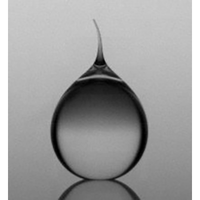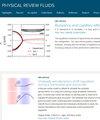低雷诺数冲击下的液滴变形
IF 2.5
3区 物理与天体物理
Q2 PHYSICS, FLUIDS & PLASMAS
引用次数: 0
摘要
通过对粘性很强的流体进行液滴冲击实验,提出了低雷诺数时液滴变形的描述方法。我们关注的是一种特殊情况,即除雷诺数外的无量纲参数不起作用,这意味着只有动能和粘性耗散决定最终变形。雷诺数大于 10 时的相同情况早在几年前就已阐明。扩散液滴的最大直径可以很好地用雷诺数的 1/5 幂定律来描述。在这里,液滴的变形(定义为接触直径乘以液滴大小)也是雷诺数的幂律。根据实验数据和比例论证,幂律的指数为 1/3。本文章由计算机程序翻译,如有差异,请以英文原文为准。

Deformation of drops at low Reynolds number impact
Drop impact experiments are performed with very viscous fluids to propose a description of the drop deformation at low Reynolds number. We focus on a specific case where dimensionless parameters other than the Reynolds number play no role, which means that only kinetic energy and viscous dissipation determine the final deformation. The same situation in the case of a Reynolds number larger than ten has been clarified years ago. The maximum diameter of the spread drop is well described by a 1/5 power law of the Reynolds number only. Here the deformation of the drop, defined as the contact diameter rescaled by the drop size, is also a power law of the Reynolds number. From experimental data and scaling arguments, the exponent of the power law is shown to be 1/3.
求助全文
通过发布文献求助,成功后即可免费获取论文全文。
去求助
来源期刊

Physical Review Fluids
Chemical Engineering-Fluid Flow and Transfer Processes
CiteScore
5.10
自引率
11.10%
发文量
488
期刊介绍:
Physical Review Fluids is APS’s newest online-only journal dedicated to publishing innovative research that will significantly advance the fundamental understanding of fluid dynamics. Physical Review Fluids expands the scope of the APS journals to include additional areas of fluid dynamics research, complements the existing Physical Review collection, and maintains the same quality and reputation that authors and subscribers expect from APS. The journal is published with the endorsement of the APS Division of Fluid Dynamics.
 求助内容:
求助内容: 应助结果提醒方式:
应助结果提醒方式:


